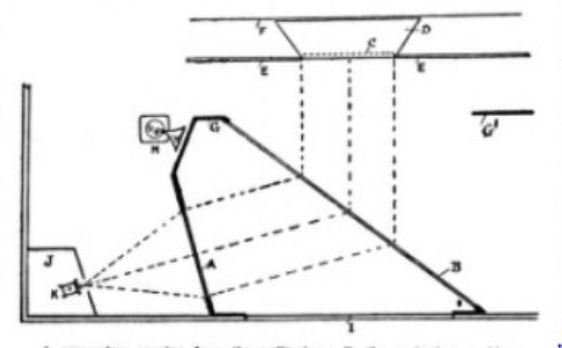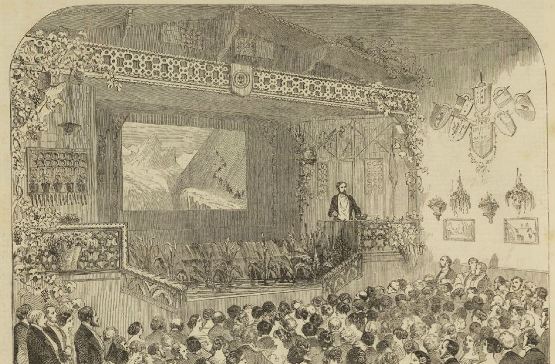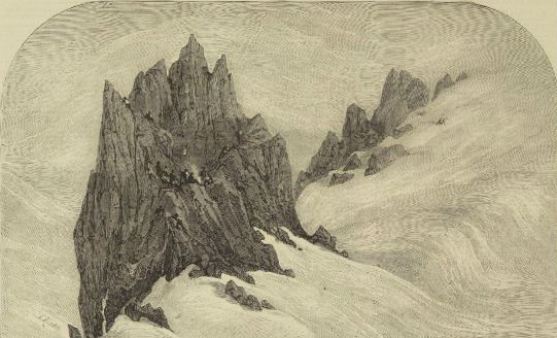Source: [George Mogridge (‘Old Humphrey’)], Old Humphrey’s Walks in London and its Neighbourhood (New York, R. Carter & Brothers, 1851, 5th ed., orig. pub. c.1843), pp. 218-226
Text: This, then, is the Cosmorama. The little book put into my hand tells me that I have eight different views to gaze on. The Rope Bridge of Penipe, in South America; the Palace of Zenobia, at Palmyra; Constantinople during the conflagration in 1839; the Palace of Versailles; General View of Rome; the Park of Versailles; the Lake of Thun, in Switzerland; and the Village of Baden.
Often and often have I reflected on the varied and almost endless gratifications which await us, both in the natural and artificial creation! Truly, if our harps are not on the willows, if our hearts are in tune, a song of thanksgiving should be ever in our mouths.
The crowded city and the rural scene,
Alike are teeming with almighty lore!
Here the great Maker of this wondrous world
Sets forth his power and goodness infinite,
In mountain, vale, and wood; and there displays
The gifted properties on man bestow’d.
Though supplied with a book, giving some account of the different paintings, and furnished with paper on which to note down any suggestion that may occur to me, this passage is so dark, that I can neither read nor write legibly, without approaching the little windows, through which I must look to see the views.
THE ROPE BRIDGE OF PENIPE is the first painting. and a striking one it is. The bridge of twisted rushes, with sticks laid across, covered with branches of trees for a flooring, is represented as stretching over the river Chambo, near the village of Penipe, from rock to rock, a distance of one hundred and twenty feet. To cross such a bridge, a strong head, a bold heart, and a steady foot must be necessary. I can fancy a timid person, following his Indian guide, while the violent oscillation of the bridge hanging in air blanches his cheek, and makes his limbs tremble. Some say, and many things are more improbable, that the notion of suspension bridges arose from the rope bridges of South America. We need not, however, have travelled so far to make the discovery, as any spider would have furnished us with a model both scientific and secure.
THE PALACE OF ZENOBIA is one of the principal remains of the city of Palmyra. The Corinthian style of architecture, with the vastness that characterized the Egyptian buildings, are both sufficiently apparent. Palmyra was the Tadmor of king Solomon, a magnificent city of Syria, the stupendous ruins of which are situated in the midst of a sandy and sterile desert, around which, on three sides, mountains rise of considerable eminence. Zenobia was queen of Palmyra. Beautiful in person, and of extraordinary intellect, she united the refinement of the Grecian with the hardihood of the Roman character: this was her palace. In the pride of her power, she thought lightly of Rome; but Aurelian came as a conqueror, and her city was swept with the besom of destruction. Palmyra was a splendid city, afterwards a towm of little note; at a still later date it was an unimportant fortress, and now it is a mere miserable village. The costly ruins of its former greatness form a strange contrast to its present humiliation; for mud cottages now stand in the spacious court of the once splendid temple.
The owlet builds her nest in princely halls;
The lizard’s slime bestreaks the palace walls;
No trace of man, save that the embers spent,
Show where the wandering Arab pitch’d his tent,
The ruin tells us that the despot’s hand
Spreads desolation o’er the wretched land;
And tombs o’erthrown, and plunder’d fanes declare
Too plain — the royal robber has been there.
As I gaze on the painting, it wonderfully improves in appearance: what was a mere picture is now a real ruin, and in fancy I am standing in the midst of its mouldering magnificence. Mark the square blocks of stone through the principal portal, and the beautiful pillars, in the distance to the left, contrasted with the strength of the foreground.
Palmyra tells a tale of other times,
War and the whirlwind have alike despoil’d her.
CONSTANTINOPLE, DURING THE CONFLAGRATION OF 1839, must have been an awful spectacle. The little device of introducing an apparent flame that bursts forth, flinging a frightful red glare on the city, and then as suddenly subsides, involving the place in portentious gloom, is very effective. It gives a reality to the representation.
What a dreadful calamity is an extensive fire! Three thousand seven hundred houses were destroyed. Despairing fathers, frantic mothers, shrieking children, bedridden and helpless old age, all at their wit’s end. Alarm visited every house! Terror strided through the streets, and destruction in all directions raged abroad.
The shout of fire! a dreadful cry,
Inpress’d each heart with deep dismay,
While the fierce blaze and redd’ning sky,
Made midnight wear the face of day.
The building at the entrance of the Bosphorous there, is the seraglio, or palace of the sultan. To the right is the dome of Santa Sophia, the most celebrated mosque of the Moslems; and yonder is Pera, where the foreign ambassadors, the dragomans, and Frank merchants reside. Visit Constantinople as you will, by the Dardanelles and sea of Marmora, by the Black Sea and the Bosphorus, by the plains of Thrace or the hills of Asia, she will always be seen to advantage.
At present, the inhabitants of Constantinople follow the false Prophet; but the Christian humbly believes that the Mohammedan crescent will yet wane before the Star of Bethlehem. In vain shall the enemies of the cross contend against almighty power; at the appointed time, “the Lamb shall overcome them; for he is Lord of lords, and King of kings: and they that are with him are called, and chosen, and faithful,” Rev. xvii. 14.
THE PALACE OF VERSAILLES is an admirable view. The building, trees, gardens, flowers, hedges, grass, and water, are all excellent. Years have passed since I looked on the real palace; but this representation of it brings it back to my gaze, as though it were just before me. The façade of one thousand nine hundred feet, the projections, Ionic columns, and statues of marble and bronze, are truly magnificent.
The centre statue, in the distance, represents Marcus Curtius leaping into the abyss, as a sacrifice for the good of his country; and the fountain on the left is the Fontaine de Pyramide, formed of four basins, one rising above another. Every spectator will be interested by this view of the palace of Versailles. Such as have seen the original will admire it for its correctness; and those who have not will be spell-bound by its beauty and magnificence.
A group of children has entered the place, to witness the wonders of the Cosmorama. They are peeping through the little windows at the different views, full of joyous exclamation. With children, pictures are always perfect.
In happy ignorance of art, they see
Beauty in every plant and spreading tree ;
Gaze on the woods and waves, with glad surprise,
And speak their pleasure with their sparkling eyes.
Let there be red, and blue, and green, and yellow enough in his brush, and a painter may calculate on the youthful world for his admirers.
This GENERAL VIEW OF ROME takes not my fancy, though it will be full of interest to those who never saw a better. St. Peter’s and the Vatican, with its colonnade, and obelisk, and fountain: the Pantheon, the Colosseum, and the Antonine and Trajan pillars, are objects which associations render attractive; but on so miniature a scale, they can scarcely be expected to be very effective. The road between the trees there would be accurately traced by the eye of a Roman Catholic, for it leads to that mother of churches, St. Giovanni Laterana, the oldest in Europe, wherein the pope is consecrated. The scene before me takes back the thought
To that proud capital, where Cesars found a home,
When Rome was all the world, and all the world was Rome.
The temple of Jupiter Stator, the ruins of the palace of the emperors, and the Fontana Paolina, the finest fountain in Rome, may all be clearly distinguished by those who have a knowledge of the once imperial city. The Corso, the finest street in Rome, may also be traced, with the Quirinal Palace, the towers of St. Maria Maggiore, and the receding waters of the river Tiber.
Though the imperial city of Rome had not, like Athens, an altar inscribed “To the unknown God,” yet did its citizens ignorantly worship stocks and stones, as the people of Athens. They were wholly given up to idolatry.
THE PARK OF VERSAILLES, like the palace, is an object which at once arrests the attention; and the longer you gaze, the more are you disposed to linger on the scene before you. The foreground, fountains, with their margins of white marble, and groups of bronze figures, are very fine; and still more magnificent is the Fountain of Latona, with the white marble figures on the red marble steps, surrounded by seventy-four gigantic frogs spouting out crystal streams. The spectator, unacquainted with the fable of Jupiter, metamorphosing the peasants of Lybia into frogs, for refusing refreshments to Latona, will be at a loss to make out what is signified by the scene.
The canal there, more than four thousand feet long, crossed by one whose length is three thousand, forms a prominent feature in the representation. I could dwell on the particular points that afford me satisfaction; but ll appear beautiful. The sky is bright, and the park is delightful. The palace and park of Versailles, most certainly, form one of the most attractive scenes in the world.
THE VILLAGE OF BADEN, though presenting to the eye of the spectator a view of one of the most picturesque spots in all Syria, is to me one of the least impressive scenes in the exhibition.
When the fierce and fiery beams of the summer sun drive away the inhabitants of Scanderoon from the marshy and unhealthy situation of their dwellings, they find an agreeable retreat in the village of Baden, where excellent fruits and good water await them. The aqueduct arches, the Santon’s tomb, the minaret and dome of the mosque, the gulf of Ajazza, and the distant mountains of Lebanon, are not without interest; but so much are they eclipsed by several of the other scenes, that I will not dwell upon them.
THE LAKE OF THUN, in Switzerland, is to me by far the most attractive representation of the Cosmorama. It is enough to make the common-place spectator imaginative, and to inspire the poetic visitant with high-wrought visions of romantic beauty. To decide whether the mountains, the trees, or the skies are the most lovely, would be an arduous undertaking. If the sublime and beautiful were ever closely connected, they are so in these smiling valleys, these cultivated hills, and mighty mountains, whose cloud-capped, icy pinnacles are lost amid the skies.
Well may such scenes be valued by the Switzer peasant! Well may they afford pleasure to him by day, and mingle with his dreams by night!
Dear is that shed to which his soul conforms,
And dear that hill that lifts him to the storms;
And as a babe, when scaring sounds molest,
Clings close arid closer to his mother’s breast.
So the loud torrent, and the whirlwind’s roar,
But bind him to his native mountains more.
The lake of Thun is more than seventeen hundred feet above the level of the sea, while the Niesen, Moine, Riger, and Jungfrau mountains lift their snowy heads thirteen thousand feet and more amid the clouds. All that is picturesque and fair in Alpine scenery seems here embodied. The river Aar, which runs below the spot whence this view is taken, descending from the Finster-Aarhorn, rolls along the base of the glaciers, collecting all their tributary waters, and distributing them among the lakes of Thun and Brienta. It afterwards pursues a course somewhat circuitous to the Rhine on the German frontier. I must now bid adieu to the Cosmorama.
In perambulating from one exhibition to another, of panoramas, dioramas, and cosmoramas; of architecture, statuary, painting, science, and literature — the thought intrudes itself. Oh that all who have talent, all who excel among mankind, would bear in mind whence their powers were derived, and would humbly adore the Giver of all good for the endowments with which he has favoured them in this world, and the revelation of his mercy through the Redeemer!
It was a desire of this kind that moved the spirit of Kirke White to fling upon his paper the following beautiful, though somewhat florid thoughts:
“Oh! I would walk
A weary journey to the farthest verge
Of the big world, to kiss that good man’s hand,
Who, in the blaze of wisdom and of art,
Preserves a lowly mind, and to his God,
Feeling the sense of his own littleness,
Is as a child in meek simplicity!
What is the pomp of learning? the parade
Of letters and of tongues? Even as the mists
Of the grey morn before the rising sun,
That pass away and perish. Earthly things
Are but the transient pageants of an hour;
And earthly pride is like the passing flower
That springs to fall, and blossoms but to die
Comments: George Mogridge (1787-1854) was a British author of travel writing, children’s books and religious tracts, frequently using the pseudonym ‘Old Humphrey’. The Cosmorama was a peepshow entertainment. Visitors entered a darkened room and peered at panoramic translucent views through a series of windows (convex lenses). The first Cosmorama opened in Paris in 1808, and the Cosmorama Room in London opened in St James’s Street in 1821, moving to 207-209 Regent’s Street in 1823. Other Cosmoramas were located across London, but Old Humphrey presumably visited the Regent Street rooms (just before this passage there is a description of the Diorama in Regent’s Park).
Links: Copy at Hathi Trust



